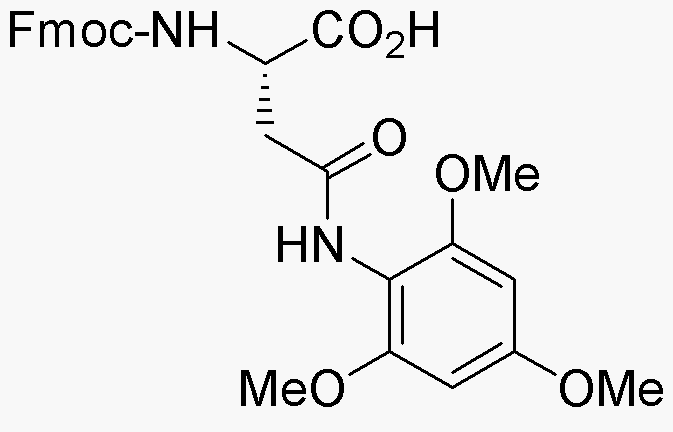Na-Fmoc-Ng-2,4,6-trimethoxybenzyl-L-asparagine is widely utilized in research focused on:
- Peptide Synthesis: This compound serves as a key building block in the synthesis of peptides, allowing researchers to create specific sequences for various biological applications.
- Drug Development: It plays a crucial role in the design of new pharmaceuticals, particularly in targeting specific proteins or enzymes, enhancing the efficacy of drug candidates.
- Bioconjugation: The chemical is used in bioconjugation processes, linking biomolecules to create targeted therapies, which is essential in developing personalized medicine.
- Research in Neuroscience: It aids in the study of neurotransmitter pathways by providing a means to modify asparagine residues in peptides, which can influence receptor interactions.
- Analytical Chemistry: The compound is utilized in various analytical techniques, helping to improve the detection and quantification of biomolecules in complex mixtures.
General Information
Properties
Safety and Regulations
Applications
Na-Fmoc-Ng-2,4,6-trimethoxybenzyl-L-asparagine is widely utilized in research focused on:
- Peptide Synthesis: This compound serves as a key building block in the synthesis of peptides, allowing researchers to create specific sequences for various biological applications.
- Drug Development: It plays a crucial role in the design of new pharmaceuticals, particularly in targeting specific proteins or enzymes, enhancing the efficacy of drug candidates.
- Bioconjugation: The chemical is used in bioconjugation processes, linking biomolecules to create targeted therapies, which is essential in developing personalized medicine.
- Research in Neuroscience: It aids in the study of neurotransmitter pathways by providing a means to modify asparagine residues in peptides, which can influence receptor interactions.
- Analytical Chemistry: The compound is utilized in various analytical techniques, helping to improve the detection and quantification of biomolecules in complex mixtures.
Documents
Safety Data Sheets (SDS)
The SDS provides comprehensive safety information on handling, storage, and disposal of the product.
Product Specification (PS)
The PS provides a comprehensive breakdown of the product’s properties, including chemical composition, physical state, purity, and storage requirements. It also details acceptable quality ranges and the product's intended applications.
Certificates of Analysis (COA)
Search for Certificates of Analysis (COA) by entering the products Lot Number. Lot and Batch Numbers can be found on a product’s label following the words ‘Lot’ or ‘Batch’.
*Catalog Number
*Lot Number
Certificates Of Origin (COO)
This COO confirms the country where the product was manufactured, and also details the materials and components used in it and whether it is derived from natural, synthetic, or other specific sources. This certificate may be required for customs, trade, and regulatory compliance.
*Catalog Number
*Lot Number
Safety Data Sheets (SDS)
The SDS provides comprehensive safety information on handling, storage, and disposal of the product.
DownloadProduct Specification (PS)
The PS provides a comprehensive breakdown of the product’s properties, including chemical composition, physical state, purity, and storage requirements. It also details acceptable quality ranges and the product's intended applications.
DownloadCertificates of Analysis (COA)
Search for Certificates of Analysis (COA) by entering the products Lot Number. Lot and Batch Numbers can be found on a product’s label following the words ‘Lot’ or ‘Batch’.
*Catalog Number
*Lot Number
Certificates Of Origin (COO)
This COO confirms the country where the product was manufactured, and also details the materials and components used in it and whether it is derived from natural, synthetic, or other specific sources. This certificate may be required for customs, trade, and regulatory compliance.


